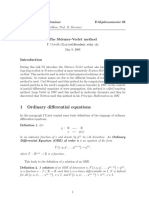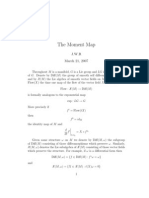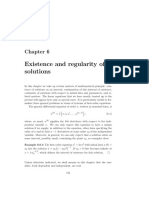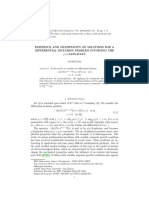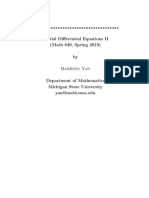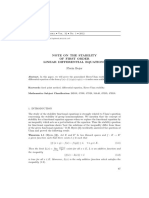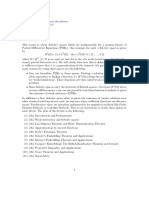0 ratings0% found this document useful (0 votes)
4 viewsAdvait LIE
Advait LIE
Uploaded by
anonymousThe document discusses properties of differential forms on Lie groups. It states that for a closed 1-form ω on a Lie group G, there exists a neighborhood U of the identity such that ω|U = dF for some function F. It then shows that F satisfies F(xy) = F(x) + F(y) on U, which implies ω is exact globally by analytic continuation.
Copyright:
© All Rights Reserved
Available Formats
Download as PDF, TXT or read online from Scribd
Advait LIE
Advait LIE
Uploaded by
anonymous0 ratings0% found this document useful (0 votes)
4 views1 pageThe document discusses properties of differential forms on Lie groups. It states that for a closed 1-form ω on a Lie group G, there exists a neighborhood U of the identity such that ω|U = dF for some function F. It then shows that F satisfies F(xy) = F(x) + F(y) on U, which implies ω is exact globally by analytic continuation.
Original Title
Advait-LIE
Copyright
© © All Rights Reserved
Available Formats
PDF, TXT or read online from Scribd
Share this document
Did you find this document useful?
Is this content inappropriate?
The document discusses properties of differential forms on Lie groups. It states that for a closed 1-form ω on a Lie group G, there exists a neighborhood U of the identity such that ω|U = dF for some function F. It then shows that F satisfies F(xy) = F(x) + F(y) on U, which implies ω is exact globally by analytic continuation.
Copyright:
© All Rights Reserved
Available Formats
Download as PDF, TXT or read online from Scribd
Download as pdf or txt
0 ratings0% found this document useful (0 votes)
4 views1 pageAdvait LIE
Advait LIE
Uploaded by
anonymousThe document discusses properties of differential forms on Lie groups. It states that for a closed 1-form ω on a Lie group G, there exists a neighborhood U of the identity such that ω|U = dF for some function F. It then shows that F satisfies F(xy) = F(x) + F(y) on U, which implies ω is exact globally by analytic continuation.
Copyright:
© All Rights Reserved
Available Formats
Download as PDF, TXT or read online from Scribd
Download as pdf or txt
You are on page 1of 1
Lie groups (Advait’s questions)
1. One has the following general statement about differential forms
on an analytic manifolds:
Lemma 1. Let ω be an exterior differential p-form on an analytic
manifold M . Let {Xi | 1 ≤ i ≤ (p + 1)} be any p + 1 vector fields on an
open set U in M . Then P
d(ω)(X1 , X2 , · · · , Xp+1 = 1≤i≤p+1 (−1)i+1 Xi · ω(X1 , X2 , · · X̂i · ·Xp+1 )
+ 1≤i<j≤p+1 (−1)i+j ω([Xi , Xj ], X1 , X2 , · · X̂i · ·X̂j · · · Xp+1 ).
P
This is proved in the chapter on Analytic Manifolds. In any case it
is an easy exercise following from the definitions especially in the case
when p = 1. Now when ω is a 1-form on a Lie group G, to check that
dω = 0, it suffices to check that dω(X, Y ) = 0 for all left translation
invariant vector fields X, Y . Now
dω(X, Y ) = X · ω(X) − Y · ω(Y ) − ω([X, Y ]). · · · · · · (∗)
Now if ω is left translation invariant, ω(X) and ω(Y ) are constant
functions, so that the first two terms in (∗) are 0. And since ω is zero
on h = [g, g] (g is the Lie algebra of G), dω = 0.
2. Since any closed form is locally exact, we see that there is a
neighbourhood U of 1 in G such that ω|U = dF for a suitable analytic
function F : U → R with F (1) = 0. Now if x, y and x · y are in V ⊂ U
connected and open and V · V ⊂ U , consider Fy (x) = F (x · y) − F (x) −
F (y) For fixed y ∈ V . Then one checks easily that dFy = 0 in V .
This means that Fy is locally constant in V and since V is connected
and Fy (1) = 0, we see that F (x · y) = F (x) + F (y) for all x, y in
V . One then appeals to the deRham Theorem which says that if M
of dimension n is any analytic manifold and for 1 ≤ p ≤ n Ωp (M )
denotes the vector space of p-forms on M , then the cohomology group
p def
HdeRham (M ) = kerneldp /imagedp−1 is isomorphic to the pth singular
cohomology group of M . If M is simply connected this implies that
every closed 1-form is necessarily of the form du for an analytic function
u on all of M . Moreover the function can be taken to have any given
value at a chosen point. Applying this to the left translation invariant
closed 1-form ω on the simply connected G, we have ω = du. Choose
u with u(1) = 0 one sees that u(x · y) = u(x) + u(y) for x, y ∈ U and
hence for all x, y ∈ G by the principle of analytic continuation.
You might also like
- Jehle Solutions PDFDocument5 pagesJehle Solutions PDFzsadiqueNo ratings yet
- The ST Ormer-Verlet Method: 1 Ordinary Differential EquationsDocument14 pagesThe ST Ormer-Verlet Method: 1 Ordinary Differential EquationsGabriel SandovalNo ratings yet
- Interior Regularity For Degenerate Equations With Drift On Homogeneous GroupsDocument18 pagesInterior Regularity For Degenerate Equations With Drift On Homogeneous Groupsguangwei871201No ratings yet
- STAT 538 Maximum Entropy Models C Marina Meil A Mmp@stat - Washington.eduDocument20 pagesSTAT 538 Maximum Entropy Models C Marina Meil A Mmp@stat - Washington.eduMatthew HagenNo ratings yet
- Some New Fixed Point Theorems For Generalized Weak Contraction in Partially Ordered Metric SpacesDocument9 pagesSome New Fixed Point Theorems For Generalized Weak Contraction in Partially Ordered Metric SpacesNaveen GulatiNo ratings yet
- The Moment Map: J.W.R March 21, 2007Document30 pagesThe Moment Map: J.W.R March 21, 2007Elba García FaildeNo ratings yet
- Lecture Notes Chapter 4 of Evans PDEDocument7 pagesLecture Notes Chapter 4 of Evans PDEJoey WachtveitlNo ratings yet
- sol3_2015Document8 pagessol3_2015gcy572092284No ratings yet
- Sandwich-Type Theorems For Meromorphic Multivalent Functions Associated With The Liu-Srivastava OperatorDocument13 pagesSandwich-Type Theorems For Meromorphic Multivalent Functions Associated With The Liu-Srivastava Operatorkumar_n38No ratings yet
- Evans PDEDocument6 pagesEvans PDEJoey WachtveitlNo ratings yet
- FDM in MatlabDocument6 pagesFDM in Matlabzahid_rehman9574No ratings yet
- Meshless and Generalized Finite Element Methods: A Survey of Some Major ResultsDocument20 pagesMeshless and Generalized Finite Element Methods: A Survey of Some Major ResultsJorge Luis Garcia ZuñigaNo ratings yet
- FernandezDocument18 pagesFernandezЕрген АйкынNo ratings yet
- Continuity of Topological Spaces: On TopologyDocument12 pagesContinuity of Topological Spaces: On TopologyShoaib ChNo ratings yet
- 1 August 22, 2012: M275 NotesDocument67 pages1 August 22, 2012: M275 NotesFacundo VignoloNo ratings yet
- KJM 2013 282Document12 pagesKJM 2013 282satitz chongNo ratings yet
- Simon - Schauder Estimate by ScalingDocument17 pagesSimon - Schauder Estimate by ScalingGiggio90No ratings yet
- Reu Project: 1 PrefaceDocument10 pagesReu Project: 1 PrefaceEpic WinNo ratings yet
- Fixed Points of Multifunctions On Regular Cone Metric SpacesDocument7 pagesFixed Points of Multifunctions On Regular Cone Metric SpaceschikakeeyNo ratings yet
- CringanuDocument10 pagesCringanuJessica GreeneNo ratings yet
- 1 Review of Topology: 1.1 Metric SpacesDocument4 pages1 Review of Topology: 1.1 Metric SpacesPrivate27No ratings yet
- Allaoui (PX) Q (X) LaplacianDocument19 pagesAllaoui (PX) Q (X) LaplacianM-k HamdaniNo ratings yet
- Analysis2011 PDFDocument235 pagesAnalysis2011 PDFMirica Mihai AntonioNo ratings yet
- Crivelli The Stormer Verlet MethodDocument14 pagesCrivelli The Stormer Verlet Methodjjj_ddd_pierreNo ratings yet
- MSRI LecturesDocument55 pagesMSRI LecturesThuy Tran Dinh VinhNo ratings yet
- Department of Mathematics Indian Institute of Technology Guwahati Problem Sheet 4Document2 pagesDepartment of Mathematics Indian Institute of Technology Guwahati Problem Sheet 4Michael CorleoneNo ratings yet
- LectureNotes_PhDCourseUniPi_PolyaSzegoDocument20 pagesLectureNotes_PhDCourseUniPi_PolyaSzegoAngelo OppioNo ratings yet
- Fon Ull 2024 NODEADocument28 pagesFon Ull 2024 NODEAWahid UllahNo ratings yet
- The Beamer Minimal Theme Black and White 1Document29 pagesThe Beamer Minimal Theme Black and White 1Anîl RåjpütNo ratings yet
- Topology502Document21 pagesTopology502alonkfirNo ratings yet
- Existence and Regularity of SolutionsDocument22 pagesExistence and Regularity of SolutionsPop RobertNo ratings yet
- MATH219 Lecture 5Document7 pagesMATH219 Lecture 5wpaul2860No ratings yet
- Notes D If Jedna CineDocument71 pagesNotes D If Jedna CinelisoviciNo ratings yet
- Proba Num GPDocument116 pagesProba Num GPkabindingNo ratings yet
- Electronic Journal of Differential Equations, Vol. 2010 (2010), No. 44, Pp. 1-9. ISSN: 1072-6691. URL: Http://ejde - Math.txstate - Edu or Http://ejde - Math.unt - Edu FTP Ejde - Math.txstate - EduDocument9 pagesElectronic Journal of Differential Equations, Vol. 2010 (2010), No. 44, Pp. 1-9. ISSN: 1072-6691. URL: Http://ejde - Math.txstate - Edu or Http://ejde - Math.unt - Edu FTP Ejde - Math.txstate - EduLuis Alberto FuentesNo ratings yet
- Differential Equations Notes: Author Vincent HuangDocument16 pagesDifferential Equations Notes: Author Vincent HuangVincent HuangNo ratings yet
- hw1 Solution 16 PDFDocument17 pageshw1 Solution 16 PDFOsho AgrawalNo ratings yet
- 849full NoteDocument94 pages849full Notesahlewel weldemichaelNo ratings yet
- TopoLOGY Presentation (FINAL)Document33 pagesTopoLOGY Presentation (FINAL)Arun KumarNo ratings yet
- Notecartan PDFDocument16 pagesNotecartan PDFLautaroAmadeiNo ratings yet
- Partial Differential Equations Example Sheet 1: BooksDocument6 pagesPartial Differential Equations Example Sheet 1: BooksNasih AhmadNo ratings yet
- A12 Rodiak GermanDocument12 pagesA12 Rodiak GermanGerman LozadaNo ratings yet
- Lecture 3: Entropy, Relative Entropy, and Mutual InformationDocument5 pagesLecture 3: Entropy, Relative Entropy, and Mutual InformationMostafa NaseriNo ratings yet
- Opuscula Math 3205 PDFDocument8 pagesOpuscula Math 3205 PDFAntonio Torres PeñaNo ratings yet
- Solutions For Singular P-Laplacian Equation in R: °2009 Springer Science + Business Media, LLCDocument17 pagesSolutions For Singular P-Laplacian Equation in R: °2009 Springer Science + Business Media, LLCp23ma0014No ratings yet
- Publi Sched ZaaDocument12 pagesPubli Sched ZaaАйкын ЕргенNo ratings yet
- Existence and Uniqueness of Singular Solutions of P-Laplacian With Absorption For Dirichlet Boundary ConditionDocument11 pagesExistence and Uniqueness of Singular Solutions of P-Laplacian With Absorption For Dirichlet Boundary ConditionJESUS ILDEFONSO DIAZ DIAZNo ratings yet
- Ito ShitDocument35 pagesIto ShitNg Ze AnNo ratings yet
- 4.Reisz-Thorin Interpolation TheoremDocument6 pages4.Reisz-Thorin Interpolation TheoremNikhil KumarNo ratings yet
- Fan 2011 - Unicidade em P (X) RadialDocument11 pagesFan 2011 - Unicidade em P (X) RadialThiago WilliamsNo ratings yet
- Corresponding Lecture NotesDocument94 pagesCorresponding Lecture NotesGlaene SantiagoNo ratings yet
- Answers To Selected Exercises - J. Reny PDFDocument5 pagesAnswers To Selected Exercises - J. Reny PDFRafael MatosNo ratings yet
- A Remark On Some Nonlinear Elliptic ProblemsDocument6 pagesA Remark On Some Nonlinear Elliptic ProblemsPatricio Cerda LoyolaNo ratings yet
- Jaafari BinonlocalDocument15 pagesJaafari BinonlocalM-k HamdaniNo ratings yet
- Math 124A Course NotesDocument36 pagesMath 124A Course NotesAmber LandisNo ratings yet
- CH 6Document54 pagesCH 6eduardoguidoNo ratings yet
- HW 2 SolnsDocument2 pagesHW 2 SolnsAsystole LethalNo ratings yet
- Fourth Order Nonlinear Random Differential EquationDocument5 pagesFourth Order Nonlinear Random Differential EquationIOSRjournalNo ratings yet
- Lecture Notes LongDocument115 pagesLecture Notes LonganonymousNo ratings yet
- MSc. ThesisDocument16 pagesMSc. ThesisanonymousNo ratings yet
- Information Brochure - Ph.D. July 2024 (Updated 23-5-2024)Document23 pagesInformation Brochure - Ph.D. July 2024 (Updated 23-5-2024)anonymousNo ratings yet
- Lie GroupsDocument6 pagesLie GroupsanonymousNo ratings yet

